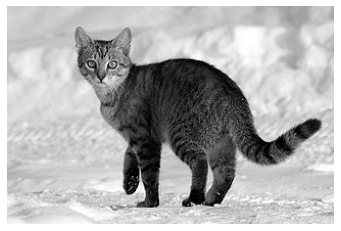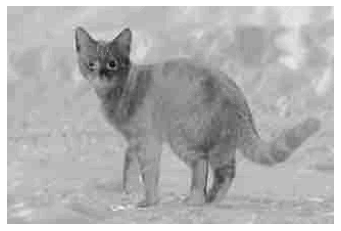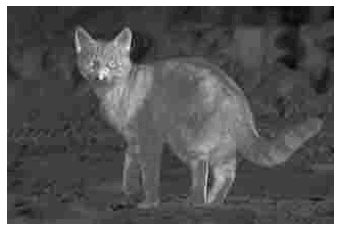 在 TensorFlow.org 上查看 在 TensorFlow.org 上查看
|
 在 Google Colab 中运行 在 Google Colab 中运行
|
 在 GitHub 上查看源代码 在 GitHub 上查看源代码
|
 下载笔记本 下载笔记本
|
概述
在计算机视觉中,所选颜色空间可能会对模型的性能产生重大影响。虽然 RGB 是最常见的颜色空间,但在许多情况下,模型在切换到其他颜色空间(如 YUV、YCbCr、XYZ (CIE) 等)时表现更好。
tensorflow-io 包提供了一系列颜色空间转换 API,可用于准备和增强图像数据。
设置
安装所需的软件包,并重新启动运行时
pip install -q tensorflow-io
下载示例图像
本教程中使用的图像示例是 雪地中的猫,但可以替换为任何 JPEG 图像。
以下操作将下载图像并将其保存到本地磁盘,文件名为 sample.jpg
curl -o sample.jpg -L https://storage.googleapis.com/download.tensorflow.org/example_images/320px-Felis_catus-cat_on_snow.jpgls -ls sample.jpg
% Total % Received % Xferd Average Speed Time Time Time Current
Dload Upload Total Spent Left Speed
100 17858 100 17858 0 0 235k 0 --:--:-- --:--:-- --:--:-- 235k
20 -rw-rw-r-- 1 kbuilder kokoro 17858 Oct 27 16:33 sample.jpg
用法
读取图像文件
读取并解码图像,将其转换为形状为 (213, 320, 3) 的 uint8 张量
import tensorflow as tf
import tensorflow_io as tfio
image = tf.image.decode_jpeg(tf.io.read_file('sample.jpg'))
print(image.shape, image.dtype)
(213, 320, 3) <dtype: 'uint8'>
可以通过以下方式显示图像
import matplotlib.pyplot as plt
plt.figure()
plt.imshow(image)
plt.axis('off')
plt.show()
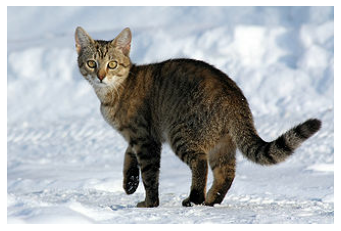
将 RGB 转换为灰度
可以使用 tfio.experimental.color.rgb_to_grayscale 将 RGB 图像转换为 灰度,从而将通道从 3 减少到 1。
grayscale = tfio.experimental.color.rgb_to_grayscale(image)
print(grayscale.shape, grayscale.dtype)
# use tf.squeeze to remove last channel for plt.imshow to display:
plt.figure()
plt.imshow(tf.squeeze(grayscale, axis=-1), cmap='gray')
plt.axis('off')
plt.show()
(213, 320, 1) <dtype: 'uint8'>
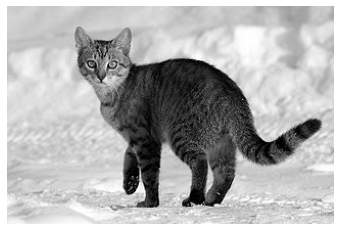
将 RGB 转换为 BGR
一些图像软件和相机制造商可能更喜欢 BGR,可以通过 tfio.experimental.color.rgb_to_bgr 获取。
bgr = tfio.experimental.color.rgb_to_bgr(image)
print(bgr.shape, bgr.dtype)
plt.figure()
plt.imshow(bgr)
plt.axis('off')
plt.show()
(213, 320, 3) <dtype: 'uint8'>
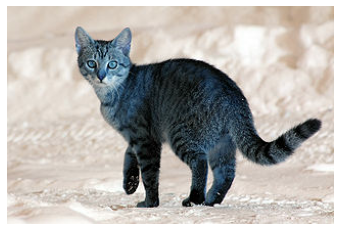
将 RGB 转换为 CIE XYZ
CIE XYZ(或 CIE 1931 XYZ)是许多图像处理程序中使用的常见颜色空间。以下是通过 tfio.experimental.color.rgb_to_xyz 从 RGB 转换为 CIE XYZ 的转换。请注意,tfio.experimental.color.rgb_to_xyz 假设浮点输入范围为 [0, 1],因此需要额外的预处理。
# convert to float32
image_float32 = tf.cast(image, tf.float32) / 255.0
xyz_float32 = tfio.experimental.color.rgb_to_xyz(image_float32)
# convert back uint8
xyz = tf.cast(xyz_float32 * 255.0, tf.uint8)
print(xyz.shape, xyz.dtype)
plt.figure()
plt.imshow(xyz)
plt.axis('off')
plt.show()
(213, 320, 3) <dtype: 'uint8'>
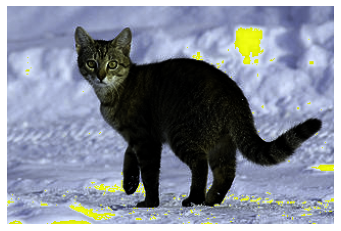
将 RGB 转换为 YCbCr
最后,YCbCr 是许多视频系统中的默认颜色空间。可以通过 tfio.experimental.color.rgb_to_ycbcr 转换为 YCbCr。
ycbcr = tfio.experimental.color.rgb_to_ycbcr(image)
print(ycbcr.shape, ycbcr.dtype)
plt.figure()
plt.imshow(ycbcr, cmap='gray')
plt.axis('off')
plt.show()
(213, 320, 3) <dtype: 'uint8'>
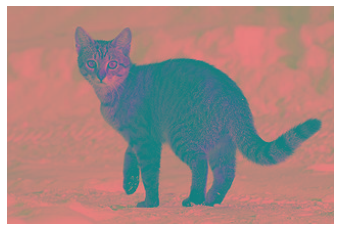
更有趣的是,YCbCr 可以分解为 Y'(亮度)、Cb(蓝色差色度)和 Cr(红色差色度)分量,每个分量都承载着感知上有意义的信息。
y, cb, cr = ycbcr[:,:,0], ycbcr[:,:,1], ycbcr[:,:,2]
# Y' component
plt.figure()
plt.imshow(y, cmap='gray')
plt.axis('off')
plt.show()
# Cb component
plt.figure()
plt.imshow(cb, cmap='gray')
plt.axis('off')
plt.show()
# Cr component
plt.figure()
plt.imshow(cr, cmap='gray')
plt.axis('off')
plt.show()
